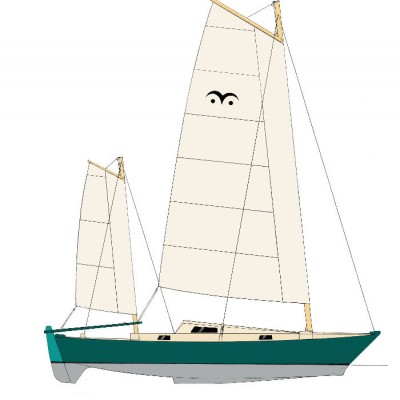Chetzemoka is the latest draft on an idea that has been slowly brewing for some time - a small multi-purpose cruiser/cargo/expedition vessel designed for the Salish Sea. It’s a motor sailor, because the wind rarely blows when you’d like it to in these parts, but you still want to be getting where you’re going. A 15-25 hp outboard will get the job done, with some wind assist via the rig.
Initial inspiration comes from the ubiquitous Filipino double outriggers, called paraws or bangkas, that handle everything from fishing to water taxi service in the Philippine Archipelago. They are a wonderfully versatile and efficient design, and even though we lack the plentiful bamboo that is used for much of its construction, this stitch and glue plywood version shares a lot of the same DNA. She is light and narrow for her length, and stability is achieved not by a weighted keel or a form stable hull, but by widely spaced outrigger hulls, or as Jim Brown says: “live buoyancy to leeward!”
Being mostly a power boat, she has no use for the high buoyancy amas of a typical modern sailing trimaran. Like the bangka, her amas are low buoyancy and low freeboard, and barely kiss the water when at rest. This saves weight, windage and drag compared to a full-on sailing vessel.
The hull shape is a simple sharpie skiff, with a medium load displacement of 3200 lb.
For accommodations, Chetzemoka has a most powerboat-like feature: an enclosed pilot house! The aft cabin includes most of the features of a long haul trucker: steering wheel, double berth, mini galley, beer cooler, and CB radio or iPhone. Forward is a 6’ exterior cockpit or cargo bay, with good storage below the sole. Forward of the cockpit is the head (where the Admiralty intended it) and a shallow bow cockpit for anchoring and attending to mast raising and lowering. The aft helm position gives good visibility of the rig when under sail. Borrowing again from the bangka, the design features wide side deck extensions that permit safe crew movement going fore and aft.
The crab claw rig is optimized for reaching and off-wind courses, and a centerboard is not even specified. It’s just so much quicker and easier to power to windward that it makes little sense to spend time and money on windward sailing devices like foils and expensive rigs. This 250 sq. ft. crab claw can be made from a flat sheet of poly-tarp if need be. There is no standing rigging, sail tracks or slides, battens, winches, or any number of items that contribute to a modern sloop’s considerable expense. The free-standing mast is only 19’-6” long and with the tabernacle it folds down to a bridge friendly air draft of 8’. That said, Chetzemoka should still be quite fast under sail with a SA/D ratio of 18.5. It would be an interesting experiment to try anti-vortex fins or “chine runners” to see if the sharp chined hull can be induced to sail to windward. There would be plenty of times when sailing while motoring would pay off with fuel savings, and I imagine the spreadsheet involved with calculating the optimum combinations of throttle with various wind speeds and headings could make a navigator geek very happy.
Even though the rig is simple, the boat is still fairly complex thanks to the outriggers, something that cannot be avoided. However, they do provide excellent kayak or dinghy storage. It wouldn’t take much argument to remove one ama and make do with a single outrigger. It would save weight, windage, overall beam, expense and build time. However, I have to say that there is something mighty pleasing about bilateral symmetry.
Chetzemoka is an evolving concept, and feedback is welcome. An intriguing thought is that when the design is scaled up to 38’, full standing headroom is available throughout.
Chetzemoka Particulars
- LOA: 28’
- BOA: 17’-3”
- Hull beam: 4’-7”
- Draft: 1’-4”
- Sail Area: 250 sq. ft.
- Displacement: 3200 lb
- SA/D ratio: 18.5
- Bruce #: 1.08
![Chetzemoka]()



















